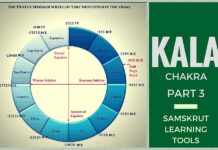
Latha Iyer
Evam pravartitam chakram – Known methods are in accordance with cycles of Nature
All Pagan religions were based on nature which means essentially all their concepts, rituals and beliefs drew inspiration from the natural world around them. Not surprising in the bit because early human interaction was essentially with nature, unlike with concrete and other man-made stuff today. Of these the chief belief was the cyclical concept of time; just like seasons come and go, time also moves in a wheel. This is the principle on which the ‘FOUR YUGAS’ of Hinduism are based as well.
In this #Kalachakra series we will explore the cyclical nature of time and apply the principle to various aspects and events of the present time. Let us begin with something we do daily- TALK.
History of speech:
It would be a good idea to look briefly into the history of speech and developement of language as we know it today. When early humans graduated to being hunters the need to communicate arose. The first form of communication was what we see today as ‘CAVE PAINTINGS’. Later sounds emerged and joining of incoherent sounds into a coherent speech is what is today known as language. Language was a highly localised phenomenon and a society speaking a single language became a nation or a state in the case of India.
Historically eras are broadly divided into ancient, medieval and modern periods. Languages change form and are refined as time goes by. As vocabulary expands and the need to identify new things comes up, more words are added to any language. Be that as it may, it also happens that at times a language dies out due to lack of usage. For example when a foreign power invades and replaces the local language with its own.
Significance:
The question then arises ‘Why is it important to resurrect a language that is considered dead’? The answer is by no means simple and definitely not without its fair share of criticism. If language is just about communicating with those around you then you certainly can make do with the existing ones. But language is also all about knowing the past and connecting with the thoughts of the ancients. The meaning is conveyed more forcefully and properly when one reads in the original tongue. And more often than not most languages do not die out fully but branch out into several other ones.
The revival:
Not every language that dies out is lost forever. Life comes a full circle when an ancient language is revived and put to use in daily life. Efforts have been stepped up in several countries to restore some of the languages that their ancestors spoke. As many as 18 languages have been listed by Wikipedia including Hebrew, Sanskrit and Latin among others as having been or in the process of being revived.
One of the earliest success stories of language revival is Hebrew. Although Hebrew had been in use as early as 10th century BCE, it ceased to be a spoken tongue from 2nd Century BCE to until about 1880 CE when the movement for its revival began. Eliezer Ben Yehuda was the one who began the revolution to claim back both the land and the language of the Jews. At that time most of the Jewish population was settled outside of what is today Israel. For the Jews it was all about reclaiming their lost culture, land and ancient glory. As they say ‘Charity begins at home’ so did Yehuda’s revival campaign. He raised his son as a child speaking only Hebrew. He didn’t, however, stop at that and took several other steps which included teaching, compiling a dictionary and founding the Hebrew Language Council. Yehuda was ably supported in his efforts by the Jewish settlers abroad who began returning home to modern Israel. Hebrew is today the official language of the country and widely spoken there.
Latin was the lingua franca of almost the whole of Europe for a long period of time until English took over this coveted position. It was spoken throughout the Roman Empire and later used by the Vatican for expanding its reach. It is the official language of the Vatican to this day and is also being studied in universities. After the 18th century vernaculars such as French, Spanish, Italian etc superseded Latin and became the language of the masses. Latin became largely confined to the scholar class during this time period. Attempts are now being made by the Vatican to revive Latin and make it appealing to the masses. Mediums such as radios during the 80s and now Twitter are being used to create interest in the language. Pontifex Latin Twitter account has been up and running since January 2013. The revival of this, however, is still a work in progress. Unlike Hebrew which faced no competition from other local languages, Latin has to vie with vernaculars to reclaim its position as a widely spoken language.
Language is not just a medium of expression but also one which connects people at various levels including cultural and nationalistic. Hence, a return in the usage of languages once widely spoken is nothing but a return to one’s roots.
As a sequel to this post we will take a look at attempts for revival of our own ancient language SANSKRIT which is undoubtedly the mother of all Indian languages.
- Revering our rivers: a story of revival - August 22, 2016
- The saga of the elephant headed God – Sripuranthan Ganesha - July 22, 2016
- Ghar Wapsi of Chola bronzes - June 20, 2016









Thank you for writing this. Please write another and another
Good.For a light reader like me ur article provides information in capsule form. Yes,it would b great if Sanskrit is revivedlike Hebrew
Nice one .. Keep it up
never knew hebrew was revived by Ben Yahuda , need some like him to revive sanskrit ,so that we can connect with bharat varsh ancient past , translations are never accurate ,.nor 1 gets the real feel of wat is written
Jainism has a similar KaalChakra with 12 time segments . Please study this for comparison. As a student of Vedanta, I find Jain version makes better sense. Kalyug started on the day of Nirvana of Mahavir Swami approx 2,500 years ago. Still have 17,500 years more to go.
Languages: Each letter has embedded subtle Science in them. Language in the subcontinent has always been present due to ever presence of basic Sanatan Dharma ( Shaivism) before evolution of Vedant and Jainism. It is therefore not true that it started with cave paintings etc on the subcontinent. Other continents -yes.
Well written. The phrase Practice what you preach ‘ would be more apt than ‘charity begins at home ‘.